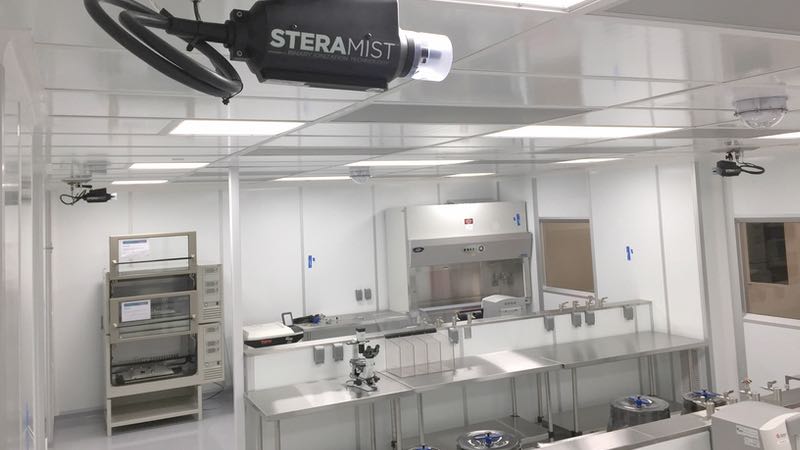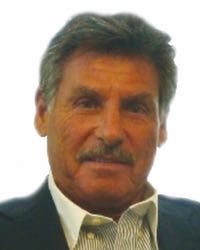Dr Halden Shane is a surgeon turned CEO that now leads TOMI Environmental Solutions as a decontamination specialist. Headquartered in California in the US, TOMI was founded by Shane almost 11 years ago and provides infection prevention and decontamination products and services to many countries and industries around the globe. The company's pride and joy is its ionised hydrogen peroxide system that provides many sectors working in aseptic environments an alternative to chlorine, ammonia, or bleach-based cleaning products.
Shane practised arthroscopic ankle surgery for over 20 years. "I was the first to apply the concepts of knee arthroscopy to the ankle, and moved away from practice in 1991," he explains. From Shane's experience as a Podiatric Surgeon, he is well aware of the issues operators face in a sterile environment. "As a surgeon, you're always conscious of aseptic spaces and sterile techniques. You learn quite a bit about infectious diseases and decontamination in medical school, so I think it was only natural for me to pick up this technology and bring it to cleanrooms and the decontamination sector."
EPA registration has been instrumental to the company's response to the pandemic
This first-hand experience informs Shane's view of the sector and helps him drive the company in a more prosperous direction. "My kindred love for microbiology from my college days that was all I needed to push me in the right direction to establish the importance of our technology."
At the centre of the storm, the decontamination sector has seen a paradigm shift as a result of the SARS-CoV-2 pandemic. "TOMI is a global company that currently serves over 26 countries around the world. Ever since the current outbreak, there has been an unprecedented demand for our product from over 53 additional countries," Shane says.
Ionised hydrogen peroxide
Shane has a revolutionary attitude to decontamination: "In my opinion, competition in the decontamination sector is essentially the same, old historic fumigation procedures and methods. Without criticising them individually, the delivery of various chemicals for decontamination has been nothing earth-shaking. You're likely familiar with them if you're reading this interview. What interested me was being able to have a technology such as iHP that did shake the earth."
The SteraMist product range that has drawn so much attention to the company in this time of need is a hydrogen peroxide decontamination system based on Binary Ionization Technology. Shane was able to purchase the technology from a public US defence company in mid-2013, which was originally designed by to neutralise weaponised anthrax. "I spent a couple of years prior to 2013 negotiating to purchase the product and finally won that right in mid-2013," he adds.
"The microscopic challenges have always been fun for me, and I can truly say that there isn't a technology out there in the cleanroom space that can challenge our efficacy with as much efficiency as iHP features."
There has been a major shift to abandon decontamination products that have been around for decades
Since the purchase of the technology, TOMI has achieved EPA registration for it. This was a big moment in the company's history and has been instrumental in its response to the pandemic. "This pandemic has [also] highlighted the importance of EPA listing, as we were able to announce efficacy against SARS-CoV-2 early on into the pandemic and still be supported by thorough EPA validation," Shane explains.
TOMI mainly serves the healthcare, life sciences, and food sectors. Shane tells Cleanroom Technology: "Our longest and largest revenue- producing division before the pandemic outbreak was Life Sciences. There has been a major shift in the Life Sciences to abandon many of the environmental decontamination products that have been around for decades. Despite how effective they were, they had incredibly toxic side-effects to humans and the environments that they were released in." He explains that the bio-safety world has been looking for a replacement for these old carcinogenic and caustic methods, and ionised hydrogen peroxide (iHP) has provided this.
The hydrogen peroxide active ingredient uses powerful radicals to destroy germs. When asked about what differs iHP from other hydrogen peroxide-based systems, Shane explains that iHP doesn't produce high ppm of a damaging decontaminant, and this decreases the damage to any material or equipment it is being applied to in comparison to higher concentrations. "The ionised hydrogen peroxide that we utilise is comprised of low-percentage hydrogen peroxide, which helps material compatibility immensely."

"[The iHP system] provides phenomenal efficacy due to the patented DARPA- developed ionisation of the solution when passing through the cold plasma arc," Shane enthuses. "This process results in ionised Hydrogen Peroxide (iHP), a fine mist or fog that contains hydroxyl radicals. Hydroxyl radicals are a powerful, natural agent that kills bacteria spores, bacteria, fungal spores and inactivates viruses on contact. The gas-like movement gives the mist the ability to spread evenly and thoroughly throughout an area, especially in the tightest of nooks and crannies that most other disinfection methods can't reach." Cold plasma is relatively new within decontamination. Shane believes that there is so much to be explored with the technology, and to watch this space.
Coronavirus
Like many decontamination specialists, TOMI has been designated as an essential business and is taking their part in this historic emergency very seriously. "We are, of course, taking the proper precautions to keep employees safe and healthy as we continue to operate," Shane explains that social distancing measures, frequent mask utilisation, hand hygiene recommendations, and office visitation restrictions are all in place.
"We were also able to receive exemptions as essential businesses for every one of our suppliers and manufactures," Shane explains. "There have been many new sectors and unique venues that have reached out. These include customers such some within the airline industry, the military, businesses, dams, gun stores, museums, and even customers wanting to treat musical instruments. We also have increased activity in our emergency, police, fire, and public transportation sectors." In a time when most businesses are out of action, TOMI is actually continuing to grow to further streamline its services and help employees to adapt to the rapidly changing corporate landscape.
This pandemic has taught the world the value of preparedness
This huge expansion from standard clientele reflects the increased global demand for these systems. However, this increased demand has also been seen in the company's usual sectors. "There has been an increase in sales for SteraMist products for both food producers and hospitals, alluding to both industries aiming to be more proactive through the use of preventive measures to stop the spread of coronavirus. Food delivery services have also turned to SteraMist for the safe transport of foods."
Concerning the use of SteraMist during an outbreak, Shane says: "We've never needed to change our protocol. TOMI did, however, have to create and implement a new, tailored protocol to use our products on PPE such as N95 masks." With the ongoing shortage of PPE, TOMI's own staff are currently using half-face mask respirators with carbon filters.
Predicting the efficacy of disinfectants has been an important step to implementing a working system to fight the pandemic. Shane shares that the procedure for TOMI involved third party labs that validated the technology's efficacy against Geobacillus stearothermophilus spores. This then proves efficacy on many more susceptible pathogens, including the coronavirus. "The similarities between SARS-CoV-2 coronavirus, MERS, SARS-1 and Influenza A as an enveloped virus, as well as efficacy against pre-existing strains of coronavirus helped to prove efficacy against the SARS-CoV-2 virus," he comments.
Infection prevention is going to be on everyone's minds in the foreseeable future, and it may prove difficult to let down our guard for quite some time
The novel aspect of this virus is perhaps the deadliest part. Understanding how to kill the virus on surfaces does not mean all the mechanisms of spreading it are also known, and this is why survivability of the virus on surfaces is still important to comprehend. Shane is keeping a close eye on any new developments: "A new analysis found that the SARS CoV-2 virus can remain viable in the air for up to 3 hours, up to 4 hours on copper, up to 24 hours on cardboard, and up to 72 hours on plastic and stainless steel. What's more, is that SARS-CoV-2 RNA was found on "a variety of surfaces" in cabins of people who were infected with COVID-19 (both symptomatic and asymptomatic) on the Diamond Princess cruise ship up to 17 days after the passengers disembarked. So we really don't know much aside from the fact that viral particles remain aloft in the air for up to 72 hours before they hit a surface and that this virus is also transferrable through surfaces."
"This pandemic has taught the world the value of preparedness, especially in the realm of high-grade disinfection," Shane says. "Just as many people have become more aware of crucial habits - such as hand washing and consideration of others when sneezing, coughing, or touching - making disinfection a critical part of your everyday routine can make all the difference in the world."
Whole room fogging or surface cleaning
One product rarely fits all facilities and the fogging method is ideal for versatility. "The initial DARPA grant was for an immune building that integrated SteraMist technology into the facility," Shane explains. "Among our product offerings are custom facility installations called Custom Engineered Systems, which offer an advanced level of control and efficacy on a large scale throughout your facility. This can be customised to pinpoint specific areas or to create a completely immune building."

Dr Halden Shane, founder and CEO of TOMI Environmental Solutions
"Making SteraMist a permanent part of your facility, lab, or cleanroom provides you with the ability to treat crucial areas via scheduled applications and does so in synchronisation with HVAC system shutoffs."
Many facilities are looking for permanently-installed decontamination solutions, but others are looking for portable measures. "Healthcare facilities may prefer the ease and control of Surface Unit application, while cleanrooms, biosafety labs and pharmaceutical companies may lean towards the Environment System for whole room fogging," Shane explains.
"The Surface Unit may be better suited for equipment decontamination, or it could be used to treat critical high-touch surfaces, spills, and clean-ups with precise manual control. Alternatively, the Environment System is extremely proficient at fogging larger spaces and multiple rooms thoroughly and evenly with scalable features. The Environment System can also be used as three hand-held Surface Units, providing additional product flexibility."
Shane reports that in the context of this SARS CoV-2 outbreak, the Surface Unit and BIT Solution have been in higher demand as people try to ensure transmission rates don't exceed their countries healthcare capacities. "I believe this [pandemic] has changed the world forever, especially within the decontamination sector. Infection prevention is going to be on everyone's minds in the foreseeable future, and it may prove difficult to let down our guard for quite some time."
